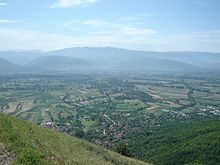
Agriculture in North Macedonia provides a livelihood for a fifth of the country's population, where half live in a rural area. Industrialisation of the country was very delayed, due to the long Ottoman domination, and then destruction from World War I and Serbian occupation. Massive agrarian reforms began under Socialist Federative Yugoslavia with its own communist rule. The continental and sub-Mediterranean climates in the country allows for a great diversity of output, but the pronounced terrain creates areas that are unexploitable for farmers. Macedonian agriculture is dominated by livestock farming, especially in its mountainous regions, viticulture, and the growing of fruit and vegetables, cereals, and tobacco. Agriculture in the country is characterised by numerous small-scale family farms, but also by large businesses, left over from the socialist era. Since its independence in 1991, the country has become a market economy. Today, agriculture accounts for 10% of North Macedonia's GDP.[1][2]
- ^ "AGRI-FOOD TRADE STATISTICAL FACTSHEET European Union — North Macedonia" (PDF). Directorate-General for Agriculture and Rural Development. 2020-03-17. Retrieved 25 May 2020.
- ^ "Candidates in EU enlargement — Agriculture". European Commission. Retrieved 25 May 2020.